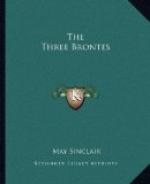It was George Henry Lewes (not a person of the finest fibre) who said of Jane Eyre that “the grand secret of its success ... as of all great and lasting successes was its reality”. In spite of crudities, absurdities, impossibilities, it remains most singularly and startlingly alive. In Jane Eyre Charlotte Bronte comes for the first time into her kingdom of the inner life. She grasps the secret, unseen springs; in her narrow range she is master of the psychology of passion and of suffering, whether she is describing the agony of the child Jane shut up in that terrible red room, or the anguish of the woman on the morning of that wedding-day that brought no wedding. Or take the scene of Jane’s flight from Thornfield, or that other scene, unsurpassed in its passion and tenderness, of her return to Rochester at Ferndean.
“To this house I came just ere dark, on an evening marked by the characteristics of sad sky, cold gale, and continued small, penetrating rain.... Even within a very short distance of the manor-house you could see nothing of it; so thick and dark grew the timber of the gloomy wood about it. Iron gates between granite pillars showed me where to enter, and passing through them, I found myself at once in the twilight of close-ranked trees. There was a grass-grown track descending the forest aisle, between hoar and knotty shafts and under branched arches. I followed it, expecting soon to reach the dwelling; but it stretched on and on, it wound far and farther: no sign of habitation or grounds was visible.... At last my way opened, the trees thinned a little; presently I beheld a railing, then the house—scarce, by this dim light, distinguishable from the trees; so dank and green were its decaying walls. Entering a portal, fastened only by a latch, I stood amidst a space of enclosed ground, from which the wood swept away in a semicircle. There were no flowers, no garden-beds; only a broad gravel-walk girdling a grass-plat, and this set in the heavy frame of the forest. The house presented two pointed gables in its front; the windows were latticed and narrow: the front-door was narrow too, one step led up to it.... It was still as a church on a week-day; the pattering rain on the forest leaves was the only sound audible....
“I heard a movement—that narrow front-door was unclosing, and some shape was about to issue from the grange.
“It opened slowly; a figure came out into the twilight and stood on the step; a man without a hat: he stretched forth his hand as if to feel whether it rained. Dark as it was I had recognized him....
“His form was of the same strong and stalwart contour as ever.... But in his countenance I saw a change: that looked desperate and brooding—that reminded me of some wronged and fettered wild beast or bird, dangerous to approach in his sullen woe. The caged eagle, whose gold-ringed eyes cruelty has extinguished, might look as looked that sightless Samson.”




